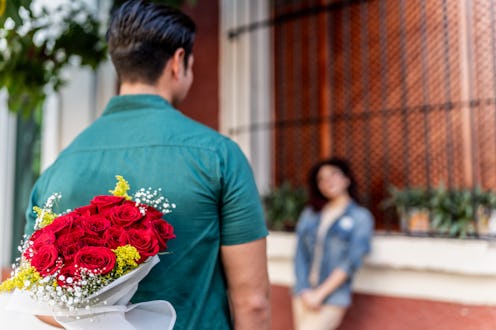
Every year on Feb. 14, people around the world celebrate love by showering lovers and friends alike with candy, flowers, and affection. While some may write off this tradition as a "greeting card holiday," where does Valentine's Day come from? It turns out that the roots of Valentine's Day actually go back a long way — to ancient Rome.
The Roman festival of Lupercalia, a celebration of fertility, was commemorated annually on Feb. 15. According to History.com, members of the Luperci, an order of Roman priests, gathered at a sacred cave where the infants Romulus and Remus, the founders of Rome, were believed to have been cared for by a wolf, or lupa. As part of the ceremony, the priests sacrificed a goat, for fertility, and a dog, for purification.
The priests then cut the goat’s hide into strips, dipped them into the sacrificial blood, and hit the streets, gently anointing both women and crop fields with the goat hide to promote fertility and prosperity in the coming year. Later in the day, as the story goes, all the young women in the city placed their names in a big urn. The city’s bachelors then each chose a name and became paired for the year with their chosen woman. These matches often ended in marriage.
How Did We Get To Romantic Love?
It wasn't until somewhere around the year 496 that Pope Gelasius I took this pagan holiday, and moved it one day earlier, thus recreating it as a Christian feast day. However, which "Valentine" Gelasius intended to celebrate is a bit murky. According to InfoPlease.com, which draws research from the Catholic Encyclopedia, there were at least three early Christian saints by that name, and all three Valentines were said to have been martyred on Feb. 14.
Though the early festivals were linked to fertility, the notion of Valentine's Day representing romantic love came later. InfoPlease.com reports that according to UCLA medieval scholar Henry Ansgar Kelly, author of "Chaucer and the Cult of Saint Valentine," it was Chaucer who first linked St. Valentine's Day with romance in the 14th century when he composed a poem in honor of the engagement between England's Richard II and Anne of Bohemia.
Additionally, during the Middle Ages, History.com reports that the French and English commonly believed that Feb. 14 was the beginning of birds’ mating season, which added to the idea that the Valentine’s Day should be a day for romance.
Today, according to a 2016 Retail Advertising and Marketing Association Valentine's Day Consumer Intentions and Actions survey published on Statistic Brain, annual Valentine's Day spending tops more than $13 billion, with people sending more than 180 million greeting cards and bestowing 198 million red roses on their hearts' desires.
But How Do We Really Feel?
Not everyone is into all of the hoopla. A 2016 study of Healthline News readers published by David Mills suggests that while the holiday is as popular as ever with those who are married, single people don't always embrace the holiday's hearts and flowers mentally. According to Mills' article, Wendy Walsh, Ph.D., a relationship expert who comments on the science of love on television and her Los Angeles-based radio show, said the number one emotion felt on Valentine’s Day is probably pressure. “People feel this societal pressure to perform on this day,” Walsh said to Mills in her interview with Healthline News.
For a number of the survey's respondents, being alone on Feb. 14 was not the end of the world. According to the survey around 58 percent said they’d “be OK” with spending the holiday by themselves. More women (60 percent) than men (52 percent) said it would be alright to be alone on Valentine's Day, which surprised me. I always think of women being more into Valentine's Day, and I still remember how devastated I felt one year when my then boyfriend presented me with a dozen red roses. When I thanked him he said, "It's no big deal, someone sent them to the bartender and she didn't want them." My "used" flowers left me feeling unappreciated and a little sad, while my boyfriend didn't seem to understand what the big deal was. Flowers are flowers, right?
Walsh advised that sharing experiences versus material items can deepen the meaning of the holiday. “Don’t take it too seriously,” she said in her interview with Mills on Healthline News. “Remember that an experience matters more than stuff.”
The oldest known valentine reportedly still in existence today was a poem written in 1415 by Charles, Duke of Orleans, to his wife while he was imprisoned in the Tower of London. He died before any of his poems could be delivered to her, but the valentine was preserved in his manuscript of poetry.
How's that for romance?
Image: FG Trade Latin/E+/Getty Images; Fotolia; GIPHY
This article was originally published on